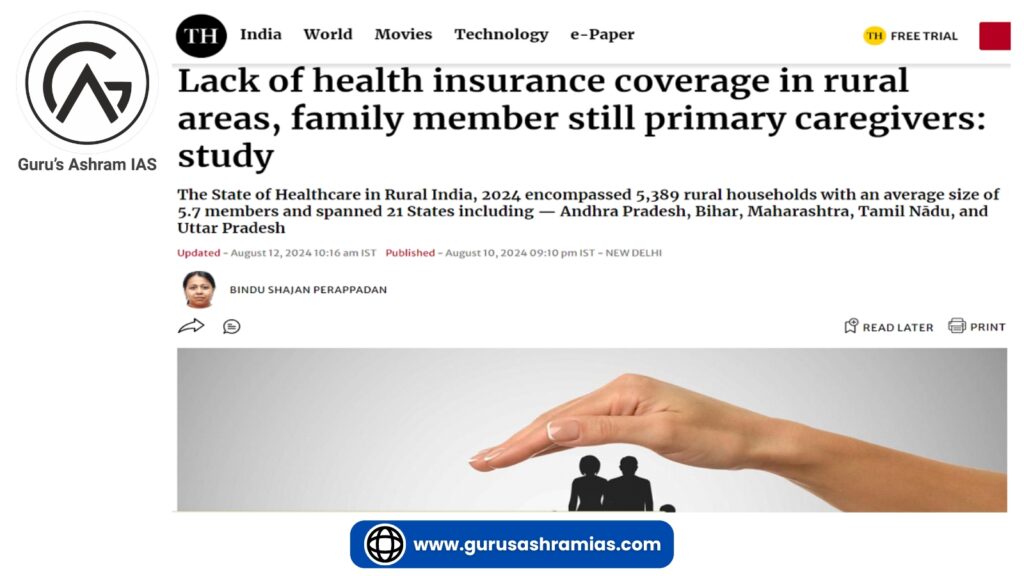‘State of Healthcare in Rural India, Report 2024’
- Recently, the ‘State of Healthcare in Rural India, 2024’ report was released by the NGO Transform Rural India and Development Intelligence Unit.
- The survey covered 21 states including Andhra Pradesh, Bihar, Maharashtra, Tamil Nadu and Uttar Pradesh.
- The samples obtained included 52.5 per cent male respondents and 47.5 per cent female respondents.
Key findings of the report:
Health insurance coverage:
- Only 50% of rural households in the country have government health insurance, while 34% have no health insurance coverage.
- 61% of surveyed households do not have life insurance.
Access to diagnostic facilities:
- The lack of diagnostic facilities is mainly due to lack of trained personnel in rural areas.
- Only 39% of the respondents have access to diagnostic centres available within commutable distance.
- 90% of the respondents do not undergo routine check-up i.e. regular health check-up without consulting the doctor.
Access to subsidized medicines:
- Only 12.2% of households have access to subsidized medicines from Pradhan Mantri Jan Aushadhi Kendras.
- Only 26% of the respondents have access to government medical stores providing free medicines located in the premises of the health facility.
- 61% of respondents have access to private medical stores within commuting distance.
Drainage system:
- 20% households reported that there is no drainage system in their villages and only 23% have drainage system in their villages.
- 43% of households had no scientific system of waste disposal and used to dump their waste anywhere.
- Only 11% of households burn dry waste and convert their wet waste into compost, while 28% reported that the local panchayat plans to collect household waste.
Care for the elderly:
- 73% of families with older population members require continuing care and the majority (95.7%) prefer family caregivers, mainly women (72.1%) who highlight the need for caregiver training on home-based care.
- Only 3% of households have employed paid external carers.
- 10% of families are dependent on neighborhood support due to the absence of caregivers.
Care for pregnant women:
- Carers of pregnant women include majority of husbands (62.7%), mothers-in-law (50%) and mothers-in-law (36.4%).
- The report emphasizes the need for strong social networks, supportive environments and capacity building for family caregivers.
Mental health disorders:
- Most of the time, 45% of the respondents based on gender have anxiety and restlessness which affects their mood.
- Anxiety and restlessness affect the mental health of older people more than younger people.
Due to poor healthcare infrastructure in rural India:
Out-of-pocket expenditure:
- According to the National Health Accounts Estimates for India (2019-20), out-of-pocket expenditure (OOPE) is 47.1 per cent of total health expenditure.
- In Odisha, 25% of households faced healthcare costs and 40% of households had to either take loans or sell assets to pay for healthcare costs after hospitalisation.
Shortage of qualified personnel:
- India suffers from an acute shortage of qualified health professionals in rural areas.
- Among the states, Chhattisgarh has the highest number of vacancies (71%) of doctors in primary health centres (PHCs), followed by West Bengal (44%), Maharashtra (37%) and Uttar Pradesh (36%).
- The total vacancies for Auxiliary Nurse and Midwife (ANM) in the country is 5%.
The doctor-patient ratio:
- The doctor-patient ratio in India is around 1:1456, which is less than the World Health Organization (WHO) recommended ratio of 1:1000.
- The situation is even worse in rural areas, where this ratio is quite high due to the shortage of doctors.
Lower public health expenditures:
- State expenditure on health is still quite low, accounting for only 1.28% of the Gross Domestic Product (GDP). Rural health infrastructure often receives a smaller share of the budget, leaving health facility centres underfunded.
Solution:
Strengthening of health insurance coverage:
- There is a need to expand the reach of government health insurance schemes like Ayushman Bharat to include the ‘vanishing middle class’ who lack access to health insurance among nearly 350 million Indians.
- This will reduce out-of-pocket expenditure and save families from falling into debt due to healthcare costs.
- All factory workers should be covered under state sponsored health insurance schemes.
- “The” “vanishing middle class” “includes population groups that are engaged in informal sector work and are not considered poor enough to benefit from state subsidized contributions to insurance premiums.”
Encouraging rural postings for healthcare workers:
- Attractive incentives such as higher salaries, better living conditions and career advancement opportunities should be provided to healthcare professionals willing to work in rural areas.
- States with high vacancies such as Chhattisgarh, West Bengal, Maharashtra and Uttar Pradesh should be given special attention.
Expansion of medical education:
- There is a need to increase the number of medical colleges and nursing schools in rural areas to ensure that students are trained with a focus on rural healthcare needs.
- This will help in improving the doctor-patient ratio.
Taking Advantage of Technology:
- Telemedicine and mobile health clinics should be used to bridge the gap in doctor-patient ratio in rural areas.
- These can help provide remote consultations and follow-up care while reducing the burden on existing health facilities.
Mobile Diagnostic Units:
- There is a need to deploy mobile diagnostic units, which can go to remote areas, provide essential diagnostic services and reduce the need for patients to travel long distances.
Community-led sanitation programmes:
- To encourage community participation in maintaining sanitation facilities and waste management.
- Programmes such as Swachh Bharat Mission should be strengthened and adapted to local needs to ensure sustainable sanitation practices.




